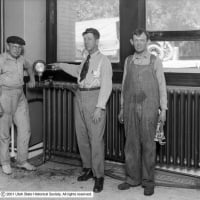Welcome! Here are the website rules, as well as some tips for using this forum.
Need to contact us? Visit https://heatinghelp.com/contact-us/.
Click here to Find a Contractor in your area.
If our community has helped you, please consider making a contribution to support this website. Thanks!
New Endurance EBP 110 water coming out of pressure relief valve
Options
Unknown
Member
but there is a brazed plate heat exchanger in it that makes domestic hot water, so the leak could technically be there. Haven't even heard of that happening except in some B. P. H. exchangers with freon on one side of them.
Boy, doesn't that mess up a system...
Noel
Boy, doesn't that mess up a system...
Noel
0
Comments
-
New Endurance EBP 110 water coming out of pressure relief valve
I am a home owner and just had an Endurance EBP 110 installed (replacement for an 18-year-old Heatmaker). After it was up and running for the first night, I found water on the floor the next morning. The plumber came back and said the pressure was too high. He "adjusted" the pressure and the water stopped. But I asked him to come back to bleed more air out of the system. After he left, I noticed the pressure was at 3 psi! I realized the inlet water valve was shut off, or at least most of the way.
Is this a common practice?
When I opened the valve, the pressure went to 12 psi and stopped. But the next morning, again water was on the floor. The pressure was at 25 psi.
What is causing the pressure to creep up over night?
Chris0 -
sounds like a faulty pressure reducing valve or bad / isolated x-tank. If the fill stopped at 12, then crept up to 25. Is the system pumping away from the e-tank? The x-tank could be bad or isolated somehow from the system, and when the water expands as it heats up, there you have it...I leave the fill on so as a fresh system expells air, it can re-charge at will, but this works best when pumping away from the x-tank...
TimJust a guy running some pipes.0 -
PRV issue
Hi Chris,
If your expansion tank is not pressurized correctly, the auto feed will add water to your system when it cools off, dumping water out the PRV when its hot. Here is what happens.
Your system is cool your pressure is at 12psi. Your system heats up, hot water expands, pressure goes up, because your expansion tank is not charged correctly(or the tank is in the wrong location), water has no place to go, PRV pops, dumping water on the floor. Now the system cools off, the pressure drops, the auto feed adds water to 12 psi and the cycle starts over again. Thats why the plumber shut the inlet water auto feed off to keep more water from entering the system. Check the expansion tank and make sure its charged correctly. As shown in the endurance manual you were reading, it should be a #30 tank. Most expansion tanks will need to be charged to 12PSI which is good for a two story home.
If the system is set up correctly, you dont need the auto feed open all the time. The system should be a closed loop system. The inlet water is only to fill the system. As the air is removed from the new system through the air vent, you may need to add a little water. This would only be for a few days until all the air is removed and the pressure is correct for the system. Then the inlet feed can be shut off.
Bill Marchant,
Applications Advisor,
Laars Heating Systems0 -
It could also be...
the expansion tank in the wrong spot. There's a zone valve inside and if tank in the wrong place it can isolate the tank rendering it useless when it shuts(or opens?).
I'd lay odds it's in the piping somewhere.0 -
Sounds off....
But I'm gonna ask...How are you making your domestic hot water?Water can only get in the system through the Pressure reducing valve, a tankless coil(Which you don't have)OR a hole in the high pressure side of an indirect,with street pressure getting to the boiler system. Good luck. Chris
0 -
Location of tank
Thanks for all the great responses.
The X-tank is located between the boiler and the zone valve. Technically, the order is boiler, circulator, x-tank, then the 4 zone valves. Is that the correct location?
If there was a problem with x-tank, would it be full of water? Or could the pressure be too high?0 -
Hey Chris
Hi Chris,
Go to page 15 of the endurance manual and look at the piping diagram. You need the bypass we talked about, then the system pump should be after the expansion tank, not before. Your pumping into the tank, dropping the system pressure. Which in turn adds water to system. Going through that whole cycle I talked about, Popping the PRV......
Thanks,
Bill Marchant
Applications Advisor
Laars Heating Systems.0 -
Bypass
Bill,
I believe that is the problem, but I don't understand how the bypass is constructed. Before I tell my plumber that it is wrong, I need to be educated about it first. :-)
Chris0
This discussion has been closed.
Categories
- All Categories
- 87.4K THE MAIN WALL
- 3.2K A-C, Heat Pumps & Refrigeration
- 61 Biomass
- 429 Carbon Monoxide Awareness
- 120 Chimneys & Flues
- 2.1K Domestic Hot Water
- 5.8K Gas Heating
- 115 Geothermal
- 167 Indoor-Air Quality
- 3.7K Oil Heating
- 77 Pipe Deterioration
- 1K Plumbing
- 6.5K Radiant Heating
- 395 Solar
- 15.7K Strictly Steam
- 3.4K Thermostats and Controls
- 56 Water Quality
- 51 Industry Classes
- 50 Job Opportunities
- 18 Recall Announcements
